Anubias is a highly sought-after aquatic plant among aquarium hobbyists due to its ease of care, beautiful & varied appearance (from Big to Mini to Snow) and versatility in size.
There are two common species of Anubias, namely Anubias barteri and Anubias heterophylla. Anubias is a genus of aquatic plants that belongs to the Araceae family. They are native to Africa and can be found growing in rivers, streams, and marshes.
Related Articles:
- 18 Types of Aquarium Moss: Photos, Care, Propagation & Growth Guide
- The 12 Best Carpeting Plants for Your Aquarium
- 16 Awesome Low Light Aquarium Plants (Mosses, Ferns & Stem Plants)
Anubias care is relatively easy compared to other aquatic plants. It can thrive in low light conditions and does not require CO2 injection, substrate or soil to thrive.
In this Anubias Care Guide, we’ll cover everything you need to know about adding Anubias to your aquarium setup. The pitfalls to watch out for, the various types of Anubias and how to keep them healthy.
Table of Contents
Pros & Cons of Adding Anubias to Your Aquarium
Pros:
- Looks Fantastic
- Hardy Plant & Low Maintenance
- Thrives in Low Light Conditions
- Perfect for small & large aquariums
- Option to float Anubias
- Doesn’t need substrate or soil
Cons:
- Prone to Algae Growth
- Can Be Expensive
- Difficult to Propagate
Common Types of Anubias
With over 30 different Anubias plant types, each with unique leaf shapes and sizes, it can be challenging to choose the perfect one for your aquarium.
In this section, we will discuss some of the most popular aquarium Anubias species and their characteristics so you’ll know if they’re a good match for your tank.
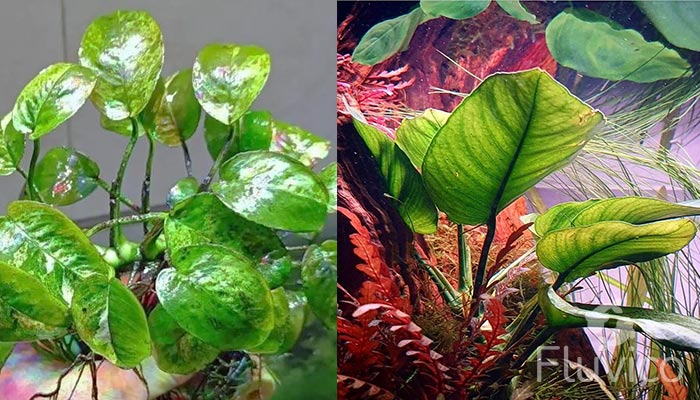
1. Anubias Barteri
Anubias barteri is known for its hardiness and ability to quickly attach itself on to various surfaces, such as driftwood or rocks, making it a versatile and easy choice for aquascaping.
- Light Level: Moderate to low light
- Size: Can grow up to 12 inches (30 cm) tall
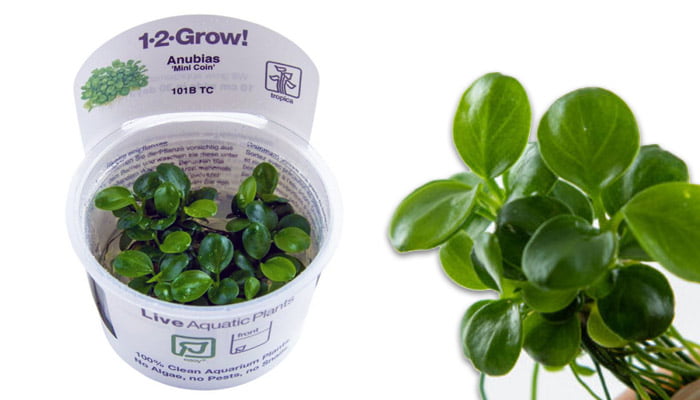
2. Anubias Nana
Anubias nana is a popular choice for nano tanks due to its compact size and slow growth rate, requiring minimal maintenance.
- Light Level: Low light
- Size: Compact size, typically around 2-6 inches (5-15 cm) tall
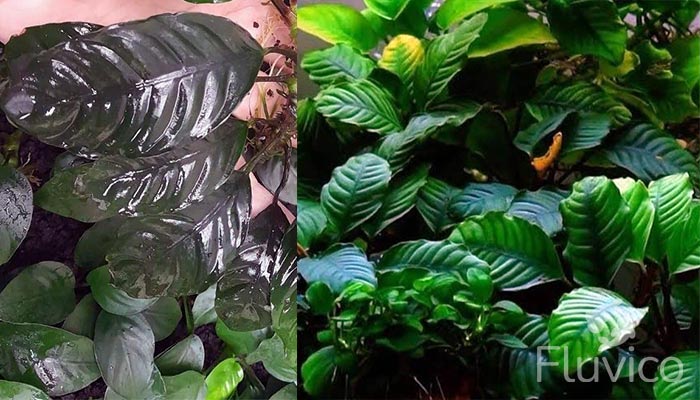
3. Anubias coffeefolia
Anubias coffeefolia features wavy, dark green leaves that can create an interesting texture contrast in an aquarium.
- Light Level: Low to moderate light
- Size: Medium-sized, reaching heights of 4-8 inches (10-20 cm)

4. Anubias lanceolata
Anubias lanceolata has elongated, spear-shaped leaves that provide a striking vertical element to an aquarium layout.
- Light Level: Moderate light
- Size: Taller growth compared to other Anubias species, reaching up to 16 inches (40 cm) tall
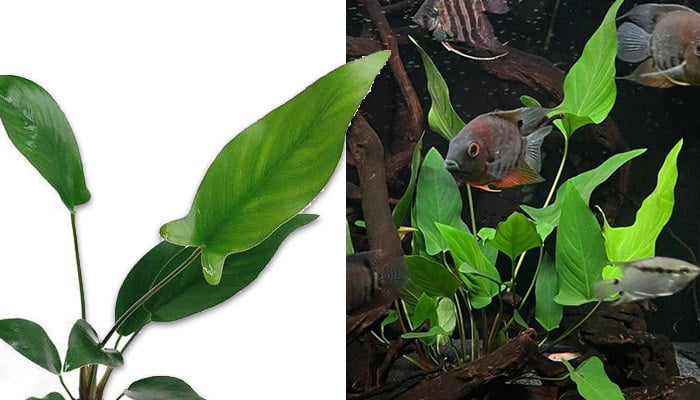
5. Anubias hastifolia
Anubias hastifolia has arrowhead-shaped leaves and is known for its robust growth, providing a lush appearance in the aquarium.
- Light Level: Moderate to high light
- Size: Taller growth, with leaves extending up to 12 inches (30 cm) long

6. Anubias Congensis & Congensis-mini
Anubias congensis has narrower, pointed leaves, giving it a distinct look that adds variety to an aquatic environment.
- Light Level: Low to moderate light
- Size: Medium-sized, typically growing up to 8-12 inches (20-30 cm) tall
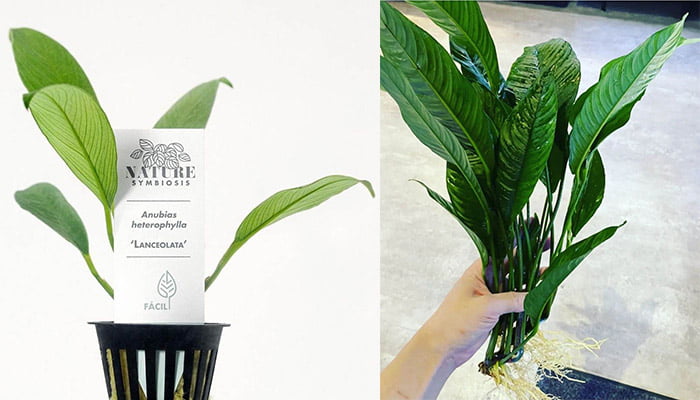
7. Anubias heterophylla
Anubias heterophylla boasts a mix of round and lance-shaped leaves, offering diverse foliage that can create an appealing aquascape.
- Light Level: Moderate light
- Size: Medium to large, reaching heights of 6-12 inches (15-30 cm)
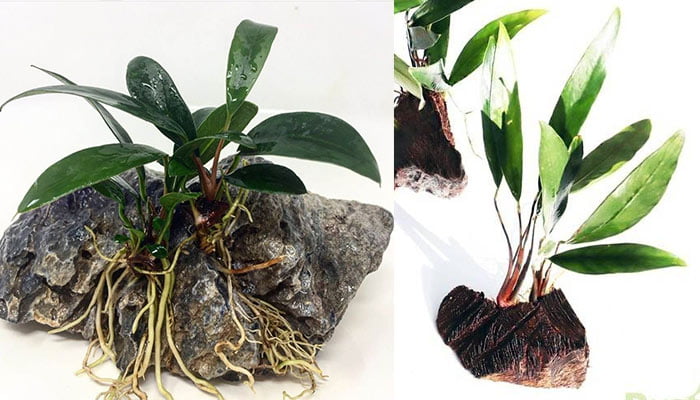
8. Anubias afzelii
Anubias afzelii has long, slender leaves, which create a graceful appearance and can be used to soften the overall look of an aquarium.
- Light Level: Moderate to high light
- Size: Medium-sized, with leaves growing up to 8-10 inches (20-25 cm) long

9. Anubias Glabra (var. Minima & Dragon Claw)
Anubias minima is a slow-growing species with delicate, slightly curved leaves, making it an excellent choice for a foreground plant in an aquascape.
- Light Level: Low to moderate light
- Size: Small and compact, usually 2-4 inches (5-10 cm) tall, ideal for foreground placement
When choosing an Anubias plant type, consider the following:
- The height of your aquarium
- Your aquascape: Whether you want foreground, background or carpeting type of Anubias.
Unique Varieties of Anubias: Nana Petite, Snow White, and Pinto
With the rise in popularity of Anubias in aquariums worldwide, we’ve seen many new species become more widely available in the last few years.
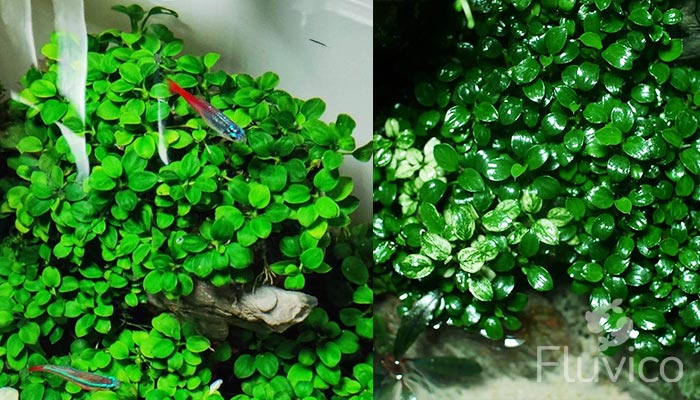
10. Anubias Nana Petite
A great for smaller tank sizes. This unique variety has a longer rhizome compared to other types of Anubias, allowing it to attach itself to driftwood or rocks with ease. The plant thrives in shade and requires minimal maintenance, making it an ideal choice for beginners.
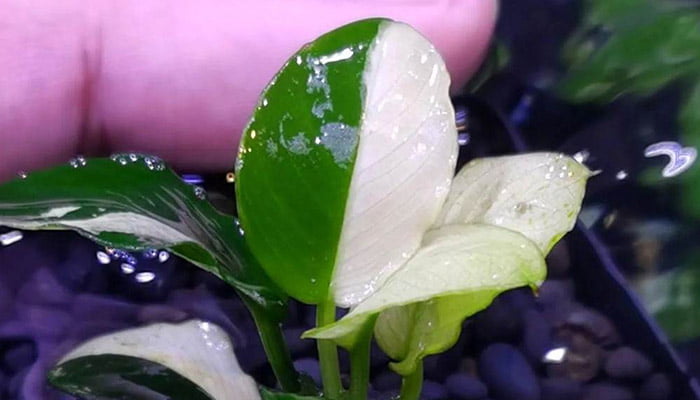
11. Snow White Anubias
If you’ve been looking to add a special plant to your aquarium, then the Snow White Anubias is perfect. Following the trend of selectively breeding plants to achieve a two-tone appearance of both green and white.
As the name suggests, this plant has white variegation on its leaves and rhizomes. It’s a slow-growing plant that prefers low light conditions and can grow up to 10 inches tall.

12. Pinto Anubias
This plant has a wide range of colours and patterns on its rhizomes, adding a bit of visual interest to any aquarium or terrarium. The Pinto Anubias grows slowly but steadily and prefers low light conditions like most other varieties of Anubias.
They require similar care as their more common counterparts. They thrive in shade and prefer water temperatures between 72-82 degrees Fahrenheit. These plants also require good water circulation but cannot tolerate strong currents.
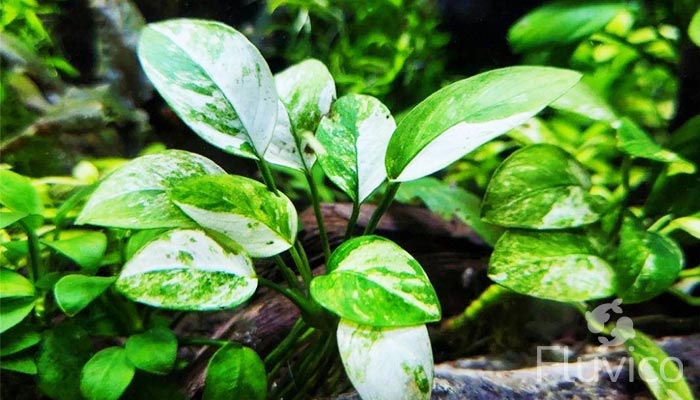
Water & Light Parameters Needed for a Healthy Anubias
Water & Light Parameters Needed for a Healthy Anubias
It is a slow-growing, hardy plant that can thrive in various water conditions. However, to ensure that your Anubias plant stays healthy and vibrant, it’s essential to maintain the right water and light parameters.
Water Parameters
Anubias thrives in a wide range of water conditions, but it prefers slightly acidic to neutral water with a pH range of 6.5 to 7.
It’s also crucial to keep the water temperature between 72°F to 82°F for optimal growth and health of your Anubias plant. Avoid sudden temperature changes as they can stress the plant and cause damage.
Maintaining moderate water flow is important for preventing stagnant water that can lead to algae growth and other problems.
Low Light Requirements
One of the reasons why Anubias is so popular among aquarium hobbyists is its low light requirements. This means that you don’t need high-intensity lighting fixtures or specialized equipment to grow this plant successfully.
You don’t need to grow Anubias in a low-light tank setup though. Through careful choice of where to plant your Anubias, you can use the natural shade of other plants to create the darker lighting environment they thrive in.
Expert Tip: In my experience growing Anubias for years in my aquariums, they can still be very healthy and produce strong growth even floated in a well-lit aquarium. These plants are great at adapting to various water and lighting conditions.
However, it’s best to avoid direct sunlight as it can cause algae growth and damage the leaves of your Anubias plant. Instead, provide indirect or filtered light for 8 to 10 hours per day.
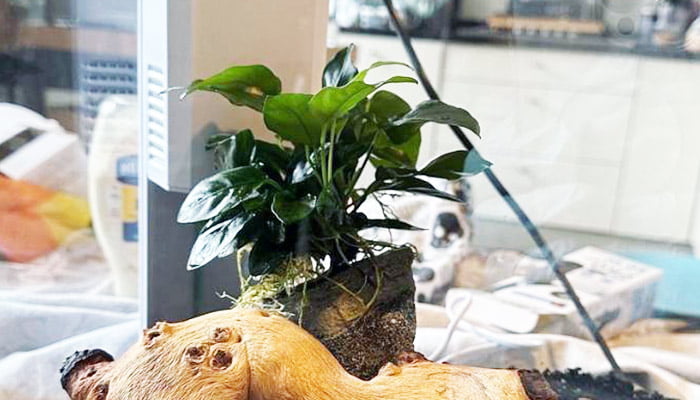
How to Grow Anubias Species and Attach Them to Hardscape
Clean the Hardscape Before Attaching the Anubias
Hardscape refers to any non-living element in an aquarium such as rocks or driftwood used for decoration purposes.
Before attaching the Anubias plant to hardscape material such as rocks or driftwood thoroughly clean them. Cleaning helps remove any dirt or debris that may contaminate the plant or damage its roots.
Cleaning also allows the Anubias to attach itself faster & more easily to your hardscape.
Use Fishing Line or Cotton Thread to Tie the Plant Securely Without Damaging Its Roots
To attach an Anubias plant securely without damaging its roots use fishing line or cotton or an aquarium safe glue or adhesive.
Position the Anubias for Optimal Growth
When attaching Anubias plants to hardscape, position them in a way that allows their leaves to spread out naturally. This will help maximize their exposure to light and promote healthy growth.
Additionally, avoid burying the Anubias rhizome in substrate as it can lead to rotting; instead, attach it securely above the substrate level.
How To Buy A Healthy Anubias For Your Aquarium?
Look for Vibrant Green Leaves
- The leaves should be free from any yellowing or brown spots, which could indicate health issues. A healthy Anubias plant will have lush green leaves that have a slightly glossy look to them.
Check the Roots
- Another important factor to consider when buying an Anubias plant is the roots.
- Healthy Anubias plants should have strong and firm roots.
- Avoid plants with roots that are brown or mushy, as this is a strong sign of root rot. Root rot can quickly spread to other plants in your aquarium.
Inspect for Pests
- Before buying an Anubias plant, inspect it carefully for any signs of pests such as snails, algae, or other unwanted organisms.
- These can quickly spread to other plants in your aquarium easily. If you notice any signs of pests on the plant, it’s best to avoid buying it altogether.
- Too late? Those pesky mystery snails have already made it into your aquarium? Check out our Fish That Love to eat snails guide.
Consider the Size
- Anubias plants come in different sizes, so choose one that is appropriate for your aquarium. A larger plant may look impressive, but it could outgrow your tank and become difficult to maintain.
- On the other hand, a smaller plant may not have enough impact on your aquascape design.
Research the Seller
- It’s important to buy from a reputable seller who specializes in aquatic plants when purchasing an Anubias plant online. Check online reviews and ratings to ensure that you are getting a healthy and high-quality plant from a trusted source.
Quarantine New Plants
- Even if you have carefully selected a healthy Anubias plant, it’s always a good idea to quarantine it for a few days before adding it to your aquarium. This will help prevent any potential diseases or pests from spreading to your other aquatic life.
What is Anubias Melt?
- Anubias melt occurs when the leaves of the plant start to disintegrate and fall off. This can happen quickly or over time, depending on the severity of the issue. The cause of Anubias melt can vary, but it’s often related to changes in the aquarium’s environment.
Triggers for Anubias Melt
- sudden change in lighting or water parameters.
- Adding new plants to your tank.
- burying the rhizome of the Anubias plant in substrate
How to propagate an Anubias?
Anubias species can be propagated through various methods, including rhizome division and cuttings.
Rhizome division involves carefully separating the plant into smaller sections with roots and leaves. This method is best done during a plant’s dormant period when it has fewer leaves and is less likely to suffer damage during separation.
Another method of propagation is through cuttings, where a stem with leaves is cut from the parent plant and planted in substrate until it develops roots. Cuttings should be taken from healthy parent plants that have strong stems and numerous leaves.
Are Anubias Good Plants for Beginners
If you’re new to the aquarium hobby or don’t have much experience caring for aquatic plants, Anubias Nana is a great choice for you.
They’re easy to care for, require minimal maintenance, and can tolerate a wide range of water conditions. Moreover, they don’t need frequent pruning or trimming like other aquatic plants, making them an excellent option for those who have busy schedules.
Is Anubias Safe for all Fish?
Yes, it’s generally safe for most fish species as it does not release any harmful chemicals or toxins into the water.
Is Anubias Safe for Turtles?
Anubias is a popular aquatic plant that is often used in aquariums and ponds. It is also known to be safe for turtles to consume and can provide a natural source of shade and hiding spots for these creatures in their enclosure.
Anubias is also an excellent food source for turtles, as it contains essential nutrients that are beneficial to their health. However, before feeding Anubias to your turtle, it is important to ensure that the plant is free from any pesticides or chemicals.
Does Anubias need Co2?
Anubias is a popular aquatic plant among aquarists due to its hardiness and low maintenance requirements. This slow-growing plant can thrive in low to medium light conditions without the need for CO2 injection. However, adding CO2 can enhance the growth rate and overall health of Anubias, especially in high-light setups.
Why won’t your Anubias Grow?
Many aquarium owners struggle to grow this plant successfully.
Common reasons for Anubias not growing:
- Insufficient lighting
- Too much shade from other plants
- Too much lightning
- This lead to increased algae growth, which can limits light exposure.
- High levels of nitrates or phosphates can negatively impact Anubias’ growth rates.
- Overcrowding of plants
- This can lead to a lack of nutrients in the water for Anubias to grow properly.
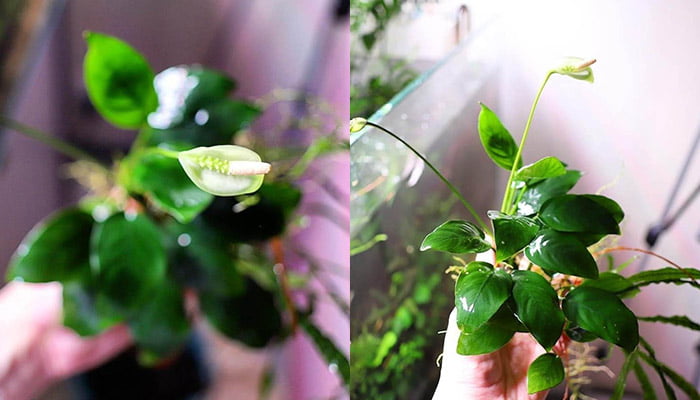
Do Anubias Plants Flower?
The answer is yes, Anubias plants do flower, but it’s rare in aquariums.
The flowering of these plants is triggered by environmental factors such as light and temperature changes. When the conditions are right, the plant will produce a small white flower that can add beauty to your aquarium.
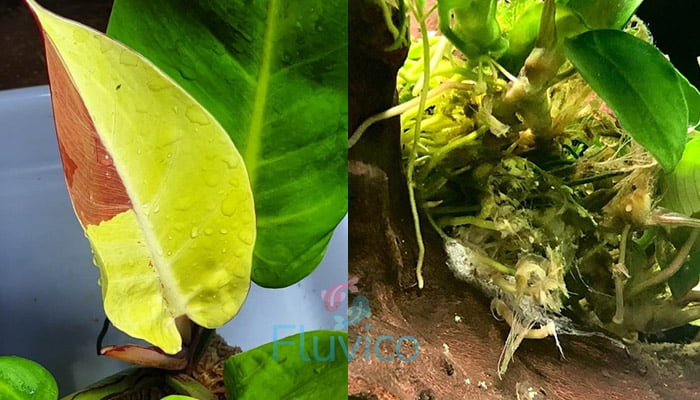
Why are my Anubias leaves Yellow?
Lack of Nutrients
If you notice yellowing leaves on your Anubias, it could be due to a lack of nutrients. Anubias requires a balanced amount of nutrients, and any deficiency in essential nutrients can cause the leaves to turn yellow.
Try adding iron & potassium to your aquarium. Iron is essential for the plant’s growth and development.
Low Light Conditions
Inadequate lighting can also lead to yellowing of Anubias leaves as they cannot photosynthesise properly
Algae Growth
If there is excessive algae growth on the leaves, it can block sunlight and cause yellowing.
Aging Leaves
Older leaves naturally turn yellow and fall off, so it’s normal for Anubias to lose some leaves over time. However, if you notice an excessive amount of yellowing leaves on your plant, it could be due to one of the other issues mentioned above.
Why are my Anubias Leaves Fading/ turning Light Green?
For the same reasons above. A lighter green leaf in comparison to its normal colour means it’s unhealthy. For the same reasons as above.
Another reason for lighter green leaves is the formation of new Anubias leaves. When the leaves are new, it’s normal for them to be a lighter shade of green while they are still orientating themselves. Once they are settled, the leaves will then darken and match the colour of the other more established leaves.
What colour are healthy Anubias leaves?
Healthy Anubias leaves are typically dark green. The shade of green may vary slightly depending on the specific species of Anubias. For instance, Anubias Barteri has darker leaves than Anubias Nana.
Is it okay to let Anubias float?
You might be wondering if it’s a good idea to let their Anubias plants float in your aquarium?
The answer is yes, it is perfectly fine to let it float in your tank. There are some benefits to doing so.
Firstly, floating Anubias can provide shade for your fish and other aquatic creatures. This can be especially beneficial if you have species that prefer lower light levels or need a place to hide from more aggressive tank mates.
Secondly, floating them can help to distribute nutrients throughout the tank. As the plant absorbs nutrients from the water column, it releases them back into the surrounding water when it floats up to the surface.
Thirdly, letting your Anubias float can make maintenance easier. When you need to clean or rearrange your tank, simply remove the floating plants and set them aside until you’re finished.
However, there are also some potential downsides to letting your Anubias float.
For example:
- Floating plants may become entangled with equipment such as filters or heaters.
- Floating plants may block out too much light if allowed to grow too densely.
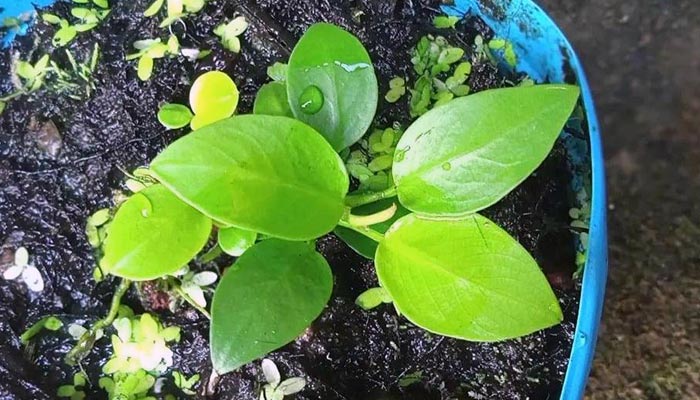
Can Anubias grow out of water?
Yes, Anubias can grow out of water.
These versatile plants are naturally adapted to living as amphibious plants, meaning they can thrive in both submerged and emergent conditions.
This makes them suitable for various setups, including paludariums, terrariums, and ripariums, where they can grow partially or fully emerged from the water.
More Reading

15 Types of Cryptocoryne: Which is Best For Your Aquarium Setup?

16 Awesome Low Light Aquarium Plants (Mosses, Ferns & Stem Plants)


18 Types of Aquarium Moss: Photos, Care, Propagation & Growth Guide
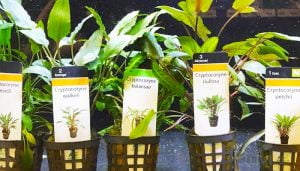
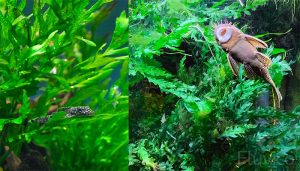
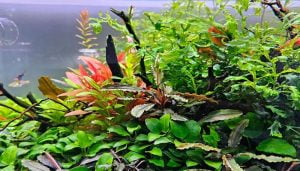



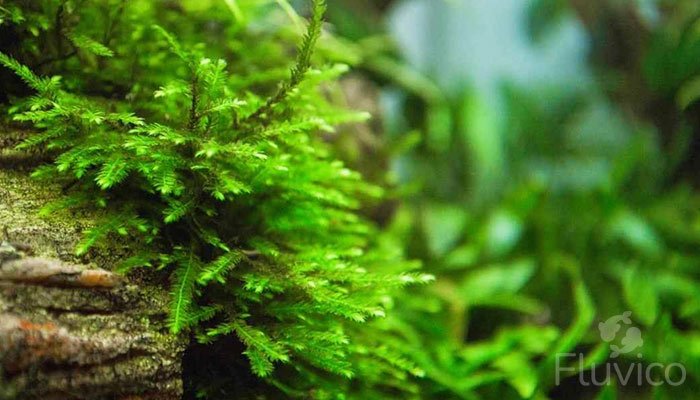
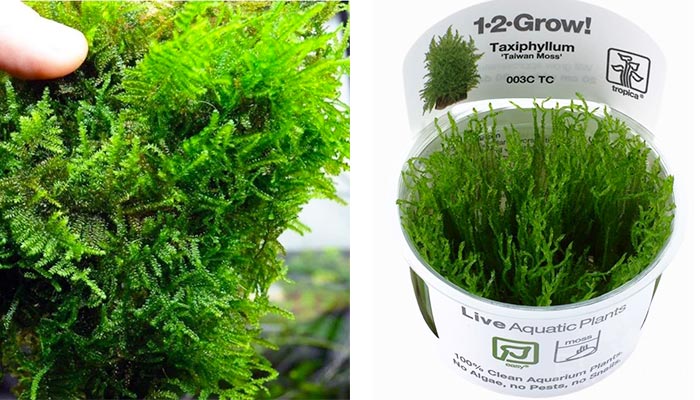
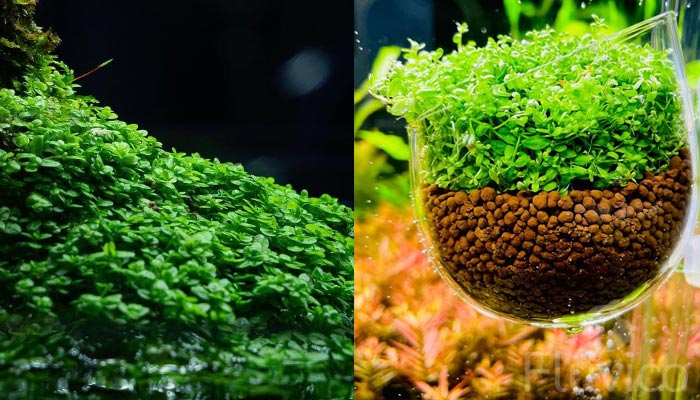
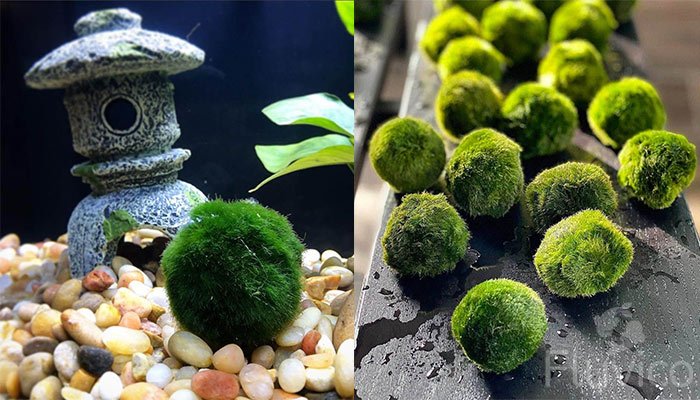
I really hope you enjoyed this Anubias Planting Tips, Types & Growth Care Guide. If you have any questions at all, just leave a comment here and I’ll do my best to answer all your Anubias Questions!
Also, I’d love to see how creative you got in your tank with Anubias?? If you can comment with a photo, I’d love to see it!
All the best,
Charlie